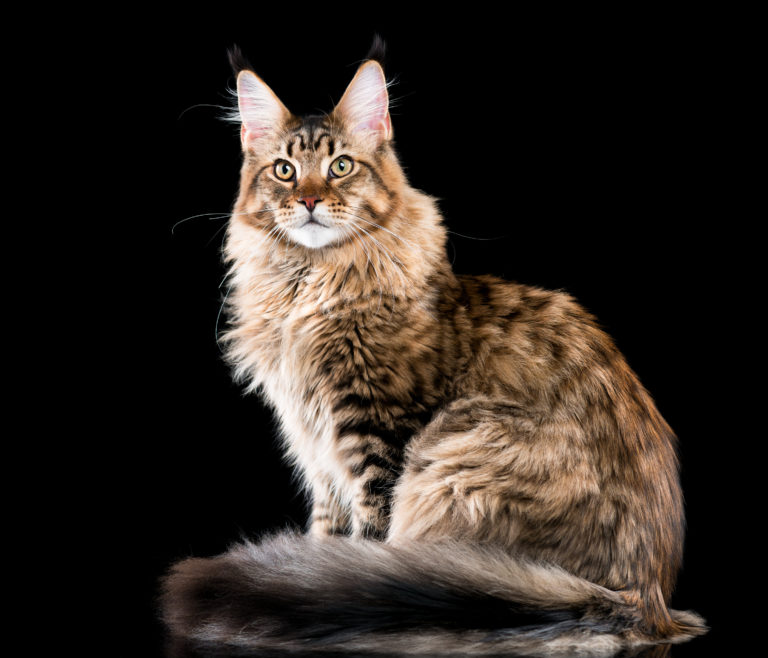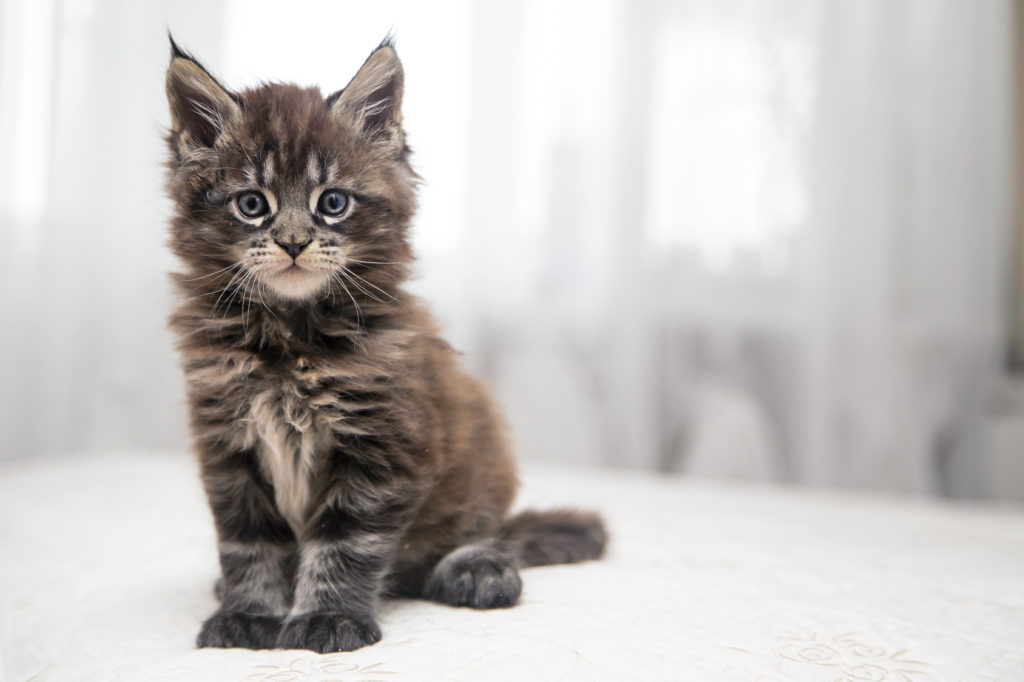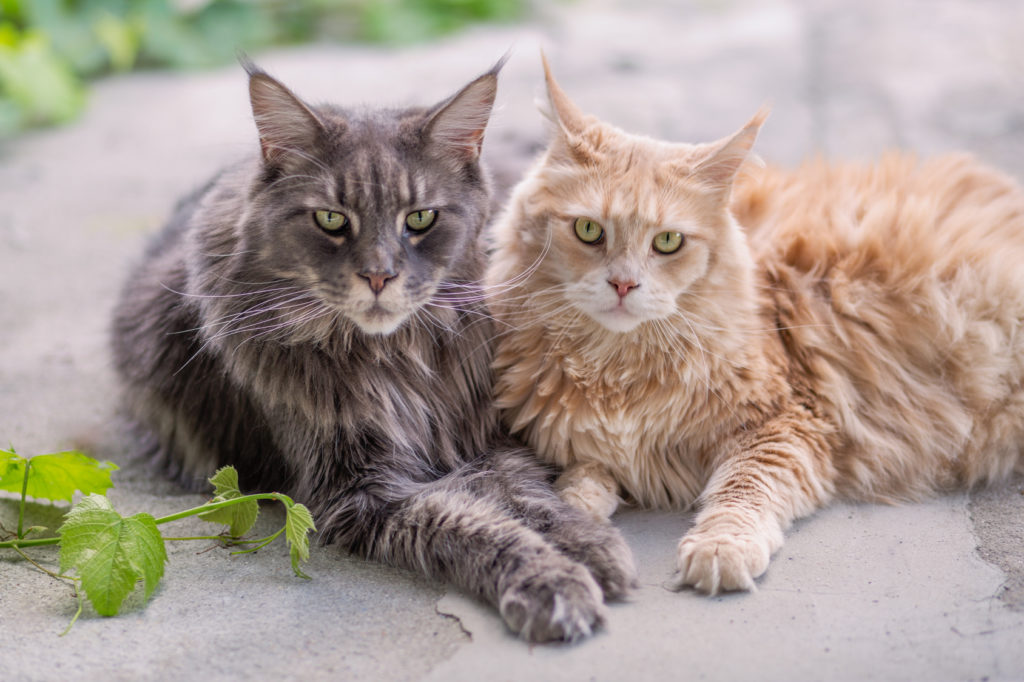The Maine Coon has become one of the most popular cat breeds in the world. This is probably due to its majestic appearance, robust nature and great character.
Maine Coon

© DenisNata / stock.adobe.com
Maine Coons are very large cats and have a muscular body.
Table of contents
Origins of the Maine Coon
The Maine Coon comes from Maine/USA, as the name suggests. In fact, they are most likely to be related to the large Norwegian Forest Cat and the Siberian Cat. There are many legends about its heritage, including wild claims that it is a mix between a cat and a raccoon. Being skilled hunters, it’s likely their ancestors were used on immigrant ships on their way to America to eliminate rats and mice. This breed was then completely forgotten, before becoming popular again in the 1950s and making regular appearances at breed shows.
Did you know that the Maine Coon is known as America’s first show cat? The inhabitants of Maine are extremely proud of their unusual cats. They were convinced that these were the smartest, fastest, strongest and, therefore, the best of all cat breeds. As far back as the 18thcentury they began comparing their Maine Coon cats with other breeds at rural folk festivals.

© lvp312 / stock.adobe.com
Character
Maine Coons are very gracious and sociable animals. They like to play and are extremely intelligent. Perfect requirements for teaching them tricks. Unlike most cat breeds, Maine Coons are also known to like water. These playful cats need a lot of attention and enrichment. They will reward you with cooing and meowing throughout the day. Their sociable character makes them compatible with other animals and children. This means, they can easily be kept as domestic cats and are perfect for working professionals. However, they are very active and should, therefore, have plenty opportunities to let off steam. Especially if they are living indoors.
Appearance
Maine Coons are usually between 6-8kg, with 5kg being a minimum weight. Their body is muscular, with a broad chest, and elongated. Maine Coons can reach up to 1.2m in length, with big, pointed ears that are tufted at the end. Their coat is water repellent, with a dense undercoat, firm hair and bushy tail. This coat can vary in colour and is found in every variant aside from golden. The Maine Coon’s legs are strong and muscular, of medium length and well-proportioned. Paws are big, round and tufted, with hair tufts on the paw pads that can protrude between the toes. There is no single clear breed standard for the Maine Coon. Polydactyly can also occur in Maine Coons; this is a genetic defect in which the cat is born with six or seven toes.
Living with a Maine Coon
Maine Coon cats are gifted hunters. These intelligent cats like to retrieve things and are great lovers of water. Do not be surprised if your Maine Coon plays with its water bowl. Scratching posts and sleeping dens need to be adapted to meet the sheer size of this breed, being tall and stable. Maine Coons are considered affectionate, however, like most cats they still need a place to hide. Cat houses are perfect hiding spots. Make sure to choose the right size litter box. The bigger, the better and the more comfortable for this large cat. Maine Coons can generally be socialised with other cats with minimal problems.
Offer plenty of enrichment
As Coonies are very active and energetic, you need to ensure there is plenty of opportunities for them to let off steam, especially if your Maine Coon is an indoor cat. Setting up a cat-safe balcony or terrace can be a great option for these felines. It is also possible to walk your Maine Coon on a lead, but you should get your cat used to this indoors before heading outside. Read our article on how to get cats used to leads. Cat toys and intelligence games should always be available to keep your clever cat entertained.

© Marta / stock.adobe.com
How do I care for my Maine Coon?
Looking at the Maine Coon’s coat, you would expect this breed to be fairly high maintenance. However, contrary to this expectation, it requires very little care and attention. This is because the breed has very little undercoat and only half-length top coat, so knots and matting do not form so easily. Therefore, combing your Maine Coon once per week should suffice. When your cat’s coat is changing you should try to groom it more frequently, and you should check your outdoor cat’s coat regularly for parasites.
The right diet
These are large cats that like to be moving and keep active, so they will naturally require a great deal of energy from their food. Different lifestyles will also play a role, with older cats having different nutritional needs from a kitten. With kittens it is especially important to ensure there is enough energy being provided, to ensure proper growth and development. General health and weight can also play a key role in determining diet. When choosing your cat’s food, be sure to look out for quality ingredients. Meat should be the main component of the food, with sugars, preservatives, grains and animal by-products being present only in small quantities. Treats and snacks will always be gratefully received, but be sure to keep these to a minimum. Pay close attention to your Maine Coon cat’s weight, as being overweight can lead to painful joint problems.
Help your cat pass hairballs
You should also offer your Maine Coon cat grass, as grooming can result in hairs being digested and forming hairballs in the stomach. Cat grass can help support your cat in vomiting these swallowed hairs, as it helps with the nauseous feeling.
Raw feeding and homemade meals are also options. Make sure you learn about your cat’s dietary needs and required nutrients before you decide on a specific diet. Remember, never feed your cat raw pork as it can transmit the Aujeszky virus. Cook all meat well before feeding.
Cats are naturally lactose intolerant, so avoid feeding your them milk. However, special cat milk with a reduced lactose content can be a great option and is generally well-tolerated, although it should be offered as a snack rather than as a water substitute.
Choose from our many dry and wet food options, and discover our range of specialist Maine Coon cat breed food!
Maine Coon Cat Breed Information
| Breed | Maine Coon, one of the largest and most popular cat breeds |
| Origin | New England |
| Temperament | Gentle, playful, good-natured, gets along with everyone (usually even dogs) |
| Size | Large, muscular build |
| Weight (female | 4-6 kg (8.8 – 13.2 lbs) |
| Weight (male) | 5-9 kg (11 – 19.8 lbs) |
| Length | Up to 120 cm (47 inches) |
| Lifespan | 12-15 years |
| Coat | Semi-longhaired, water-resistant with a soft undercoat |
| Coat colors | All colors are possible, both solid and tabby, with the base colors white, black, and red |
| Eye color | Light and clear, corresponding to the coat color |
| Price | £1000-1200 per kitten (price depends on pedigree and breeder) |
| Health | Generally healthy breed. Rare genetic conditions include hypertrophic cardiomyopathy, musculoskeletal disorders, spinal muscular atrophy, and polycystic kidney disease |
| Shedding | Can shed more than average if they don’t get enough exercise |
Here are some purchase proposals curated by the zooplus editorial team
The products featured have been carefully selected by our editorial staff and are available at the zooplus online pet shop. The selection does not constitute advertising for the mentioned brands.